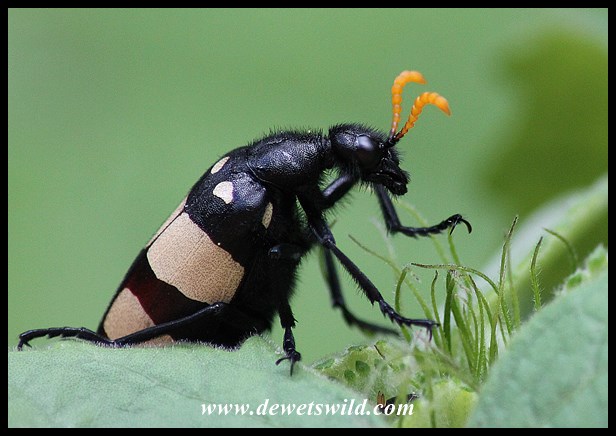Mylabris oculata
The CMR Blister Beetle is a large (4cm long) and colourfully-marked beetle in the family Meloidae, notorious for excreting the toxin cantharidin in defence against predators – this can cause blisters when making contact with skin and can even be fatal if ingested, both to humans and livestock.
After mating, the female lays her eggs in the ground. After hatching the larvae of the CMR Blister Beetle feeds on grasshopper eggs (including those of plague-causing locusts), while the adults feed on flowers and, often congregating in large numbers on flowering plants, are considered a pest in gardens and orchards. They are slow-flying insects. Adults are most often seen between late spring and early autumn. CMR Blister Beetles have very few specific habitat requirements and occur in almost every corner of South Africa.
The “CMR” acronym in this blister beetle’s name comes from the Cape Mounted Rifles, a military unit from South Africa’s colonial past whose colours resembled this beetle’s. In turn, the CMR Blister Beetle then became part of the Cape Mounted Rifles’ insignia.












My ouma het hulle aan n draad ingeryg en in hulle in die bome opgehang. Dit was n goeie manier om die ander gomtorre af te skrik!
My grandma used to string these insects on a thing wire which she then hung in the trees to scare the other insects away. I will never forget how they used to still flutter and made an awful noise but they were not going anywhere.
LikeLike
Ek kan my indink dat dit n grusame gesig sou wees vir enige tor!
LikeLike
Toe nou nie sommer ‘n gewone gom-tor nie! ‘n Army gom-tor die! 😲🤪
LikeLiked by 1 person
Net so, AJ! Hierdie een glo aan “chemical warfare”!
LikeLike
Wha ha HAA!!! 😵🤣
LikeLiked by 1 person
Interesting creature!
LikeLiked by 1 person
Thanks Montucky – we think so too!
LikeLiked by 1 person
Wulpse gogga tor!
LikeLiked by 1 person
As mens kyk hoe baie van hulle saamkoek soms dan moet ek met jou saamstem, Tina!
LikeLiked by 1 person
A very beautiful beetle!😊 I didn’t know there were poisonous beetles. Love your blog because you show all kinds of animals that you have in your terrific country! Animal planet, Nat geo wild and other channels shows almost only large animal animals, lion cheetahs, buffaloes and other larger animals in 99% of the time. Sure, it’s fun to watch, but I want to see all the animals, and you show them! Animal channel in blog form!😄😄😄
LikeLiked by 1 person
That really is what we love to do, John, and thank you for your very kind words. South Africa really is a country so rich in wildlife treasures and we’re glad that we are able to share a tiny bit of it with the world through our blog.
LikeLiked by 1 person
Daardie torre het baie van die mielies se stuifmeel gehou. Ek kannie onthou dat hul so gebrand het nie. Het hul dalk nie regtig vasgevat met my vingers nie.Hul het nie baie aangenaam geruik as ek so onthou nie.(Dalk is ek bietjie deurmekaar!)
LikeLiked by 2 people
Ek dink jy dink dalk aan die mieliekewer, Ineke. Hulle lyk nogal dieselfde, maar is baie kleiner as hierdie Blaartrekkewer. Kyk bietjie: https://myrmecos.wordpress.com/2009/05/22/friday-beetle-blogging-spotted-maize-beetle/
LikeLike
Ja dis waar noudat jy dit noem. My kop het bietjie deurmekaar geraak. Hul is ook nie in massas soos die mielikewertjies nie. Hul het ook meer strepe op en was/is groter.
LikeLiked by 1 person
It is good to see something we have grown up with showcased so well.
LikeLiked by 1 person
Isn’t it wonderful that some of the most interesting things you could hope to see live right in your back yard!?
LikeLike
It appears that this beetle could cause a lot of pain.
LikeLiked by 1 person
And that usually comes as quite a surprise to anyone thinking they’re safe to pick up!
LikeLike
Yes!!!
LikeLiked by 1 person
Beautiful but somewhat deadly. Those two seem to go together often in nature, don’t they? 🙂 Thanks for sharing.
janet
LikeLiked by 1 person
Absolutely, Janet!
LikeLike
You are a wonderful science teacher showing me the world! Really! Thanks!
LikeLiked by 1 person
That’s very kind of you, Robert. We just love being able to share our beautiful country’s treasures with you all!
LikeLiked by 1 person
a very beautiful bug.
LikeLiked by 1 person
Beautiful and deadly!
LikeLike
CMR! I would have never guessed it stands for Cape Mounted Rifles. Very appropriate name for the beetle, as shown in your beautiful photos of it.
LikeLiked by 1 person
Thank you very much, Hien!
The name definitely is one-of-a-kind!
LikeLike